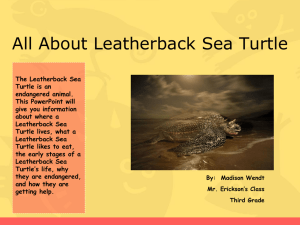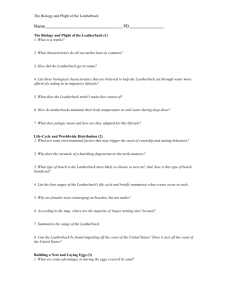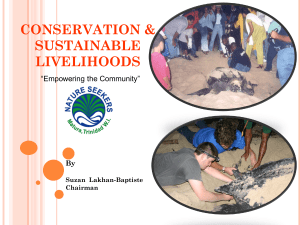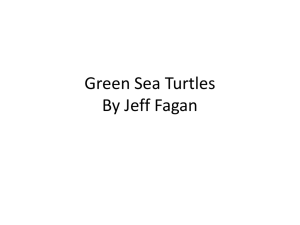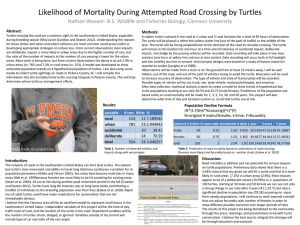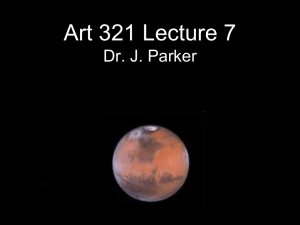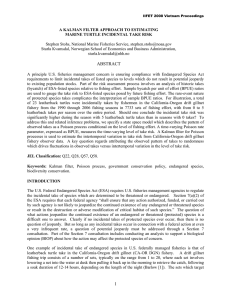Leatherback sea turtle - Science6
advertisement
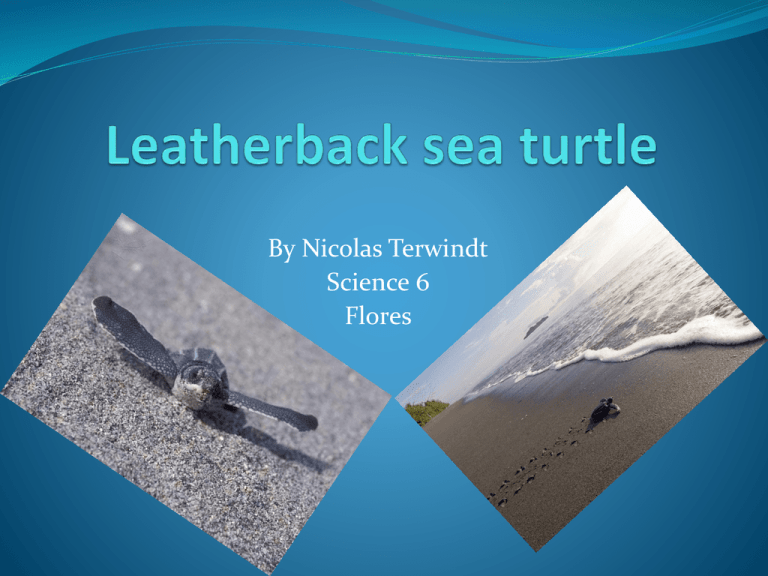
By Nicolas Terwindt Science 6 Flores Characteristics The adult leatherback sea turtles weigh 2000 pounds. The babies weigh around 45 grams. The adults are 6 foot 5 inches long. The babies are 50-70 centimeters. There are 34,000 nesting females. They eat jellyfish, fish, and algae. Their shell is black with pinkish white dots. They are found in warmer oceans. They are on the top of the food chain. The leatherback sea turtles population is decreasing as listed below Reasons for decrease There are many factors why the leatherback sea turtles are endangered. The main abiotic factors are: They mistake plastic bags. People poach the eggs and the flesh of the leatherback sea turtle. They get caught in commercial fishing nets. And loss of their habitats in remote stretches of sandy beaches. Biotic factors Humans They eat the leatherback sea turtles They poach the leatherback sea turtles and their eggs Abiotic factors Plastic and plastic bags They mistake plastic for jellyfish and choke and die Habitat destruction Loss of habitat No place for the leatherback sea turtle to nest Nets The leatherback sea turtles can caught inside of them Leatherback sea turtle mistaking plastic as a jellyfish Leatherback sea turtle egg getting poached Leatherback sea turtle getting stuck in fishing net Leatherback sea turtles habitat getting destroyed by oil Conservation methods Some people invented a TED ( Turtle Excluder devices) It allows fisherman to still catch the fish but also if a turtle gets stuck they can go through a little hole. There are a few other conservation ideas and groups that are looking for donated money to get started. These methods helped to increase the population of leatherback sea turtles. Which will then help fisheries etc. Why is this important????? It is important to save the leatherback sea turtle because they don’t do anything to humans we just kill them They help swimmers not to get stung by poisonous jellyfish and make them go to the hospital or something like that How do the leatherback sea turtles affect us They do not harm people They eat jellyfish which eat good fish from fisheries They are the largest reptiles on the earth They need your help, OR ELSE They will join all of the other unlucky animals who got extinct. Don’t let this happen, Save the Leatherback sea turtle!!!! Bibliography Leatherback Turtle Hatchling. Photography. Encyclopædia Britannica Image Quest. Web. 22 Mar 2012. http://quest.eb.com/images/139_1931647 Leatherback Turtle Hatchling. Photography. Encyclopædia Britannica Image Quest. Web. 22 Mar 2012. http://quest.eb.com/images/132_1313868 “leatherback turtle.” WWF. N.p., n.d. Web. 7 Feb. 2012. <http://www.worldwildlife.org/species/finder/leatherbackturtle/leatherbackturtle.html>. “SEA TURTLES.” Animals. N.p., n.d. Web. 1 Mar. 2012. <http://www.seaworld.org/animal-info/info-books/sea-turtle/habitat-&distribution.htm>. Wallace, Bryan. “Deep-diving adaptations of Leatherback turtles.” deep sea news. N.p., n.d. Web. 1 Mar. 2012. <http://deepseanews.com/2009/04/deep-diving-adaptations-of-leatherback-turtles/>. Leatherback Turtle. Photography. Encyclopædia Britannica Image Quest. Web. 26 Mar 2012. http://quest.eb.com/images/149_2099551 Blue Jay. N.p., n.d. Web. 26 Mar. 2012. <http://www.blujaybb.com/index.php?topic=11900.255>. “Leatherback sea turtle.” AMNH. N.p., n.d. Web. 25 Mar. 2012. <http://www.amnh.org/nationalcenter/Endangered/turtle/turtle.html>. “leatherback turtle.” WWF. N.p., n.d. Web. 7 Feb. 2012. <http://www.worldwildlife.org/species/finder/leatherbackturtle/leatherbackturtle.html>. “9000 stolen turtle eggs discovered off the coast of French Guiana; egg theft a major threat to turtle survival in the Guianas.” green antilles. N.p., n.d. Web. 26 Mar. 2012. <http://www.greenantilles.com/2012/03/12/9000-poached-sea-turtle-eggs-discovered-in-frenchguiana-egg-poaching-a-major-problem-in-the-area/>. “oil spills.” think quest. N.p., n.d. Web. 26 Mar. 2012. <http://library.thinkquest.org/CR0215471/oil_spills.htm>. “Photos and population trend graphs.” esa success. N.p., n.d. Web. 25 Mar. 2012. <http://www.esasuccess.org/reports/northeast/ne_species/study/esa-success-ne-photos-population-graphs.pdf>. “plastic in the pacific ocean.” Be Green Journal. N.p., n.d. Web. 25 Mar. 2012. <http://www.begreenjournal.com/post/2010/10/14/Plasticin-the-Pacific-Ocean.aspx>. “SEA TURTLES.” Animals. N.p., n.d. Web. 1 Mar. 2012. <http://www.seaworld.org/animal-info/info-books/sea-turtle/habitat-&distribution.htm>. “turtle excluder devices.” noaa. N.p., n.d. Web. 26 Mar. 2012. <http://www.nmfs.noaa.gov/pr/species/turtles/teds.htm>. Wallace, Bryan. “Deep-diving adaptations of Leatherback turtles.” deep sea news. N.p., n.d. Web. 1 Mar. 2012. <http://deepseanews.com/2009/04/deep-diving-adaptations-of-leatherback-turtles/>.
